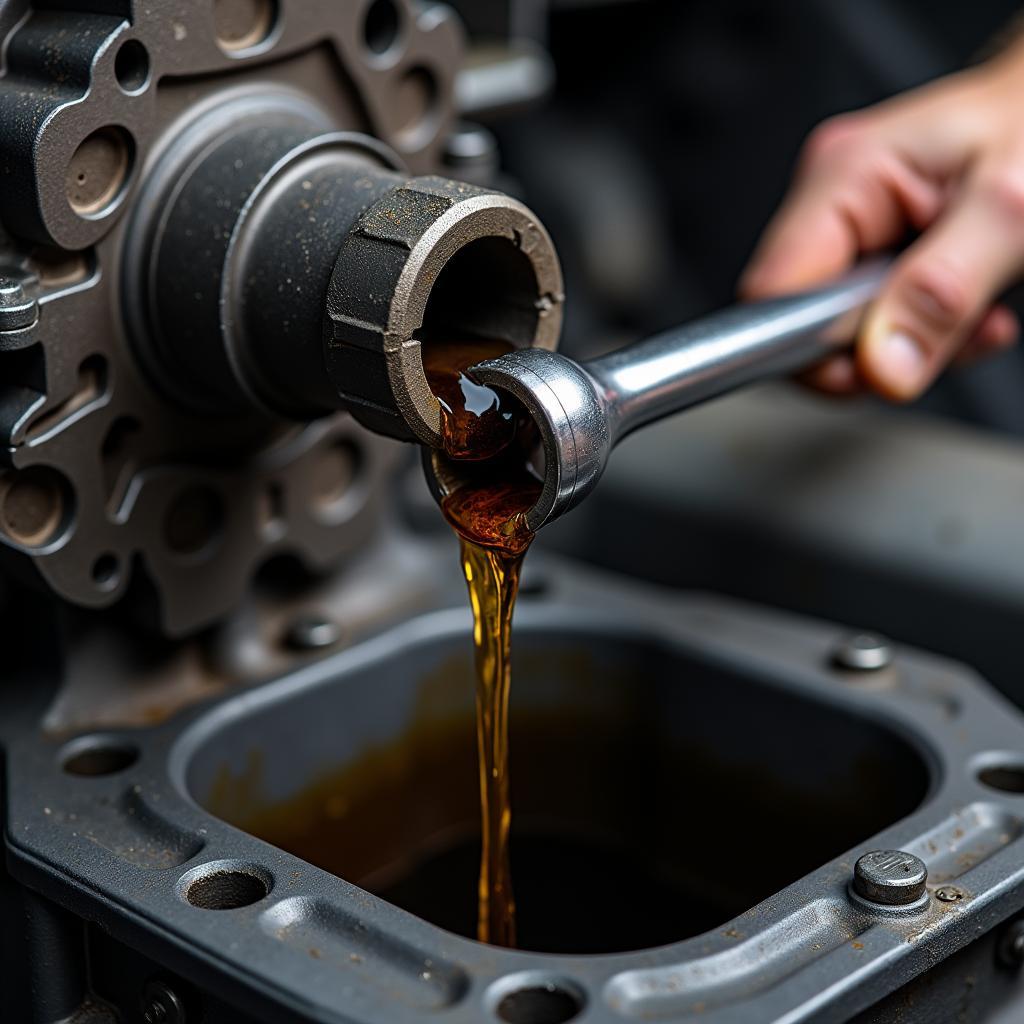Servicing your car’s manual gearbox is crucial for ensuring smooth shifting, maximizing fuel efficiency, and extending the lifespan of your transmission. While it might seem daunting, understanding the basics of manual gearbox service can save you money on costly repairs down the road.
This comprehensive guide will walk you through the essential steps involved in servicing a car manual gearbox, equipping you with the knowledge to confidently tackle this important maintenance task.
Understanding Your Car’s Manual Gearbox
Before diving into the servicing process, it’s helpful to grasp the fundamental components and their function within a manual gearbox.
A manual gearbox, also known as a standard transmission, uses a system of gears and a clutch to transfer power from your engine to the wheels. The driver manually selects the appropriate gear using the gear stick, which engages specific gear combinations within the gearbox.
Here are the primary components of a manual gearbox:
- Input shaft: Connected to the engine’s clutch, it receives power and transmits it to the gear cluster.
- Output shaft: Delivers power from the gearbox to the wheels.
- Gear cluster: Consists of various sized gears that mesh to create different gear ratios.
- Synchronizers: Smooth gear changes by matching the speed of the gears before they engage.
- Gearbox casing: Houses and protects all the internal components, filled with gear oil.
Essential Tools and Materials
Before you begin servicing your manual gearbox, gather the following tools and materials:
- Car ramps or jack stands
- Wheel chocks
- Drain pan
- Ratchet and socket set
- Torque wrench
- Clean rags
- New gearbox oil
- Replacement drain plug washer
- Gloves
- Safety glasses
Step-by-Step Guide to Servicing Your Manual Gearbox
Follow these detailed steps to effectively service your car’s manual gearbox:
1. Prepare Your Vehicle
- Safety First: Park your car on a level surface and engage the parking brake. Use wheel chocks to secure the rear wheels.
- Elevate Your Car: Safely raise the front of your car using car ramps or a jack and jack stands. Ensure the car is stable before proceeding.
2. Locate and Drain the Gear Oil
- Identify the Drain Plug: The drain plug is typically located at the lowest point of the gearbox casing. Consult your car’s manual for its exact location.
- Position the Drain Pan: Place a drain pan underneath the drain plug to collect the used gear oil.
- Loosen and Remove the Drain Plug: Use a ratchet and socket to loosen the drain plug. Finish unscrewing the plug by hand, allowing the oil to drain completely.
 Draining Gear Oil From a Manual Gearbox
Draining Gear Oil From a Manual Gearbox
3. Replace the Drain Plug and Washer
- Inspect the Drain Plug: Check the drain plug for any damage or excessive wear. Replace it if necessary.
- Install a New Washer: Always replace the drain plug washer with a new one to ensure a proper seal.
- Tighten the Drain Plug: Reinstall the drain plug with the new washer and tighten it to the manufacturer’s specified torque.
4. Refill with Fresh Gear Oil
- Locate the Fill Plug: Consult your car’s manual to identify the fill plug location. It’s usually positioned higher on the gearbox casing.
- Add New Gear Oil: Using a funnel, carefully pour the recommended type and quantity of gear oil into the gearbox through the fill hole.
- Check the Oil Level: Once full, the oil should be level with the bottom of the fill hole. You can use your finger or a dipstick (if applicable) to confirm.
- Reinstall the Fill Plug: Securely tighten the fill plug to prevent leaks.
5. Lower Your Car and Dispose of Used Oil
- Lower the Vehicle: Carefully lower your car from the ramps or jack stands.
- Dispose of Used Oil: Responsibly dispose of the used gear oil at a designated recycling center or auto shop.
Signs Your Manual Gearbox Needs Attention
Recognizing the signs of a gearbox problem can help you address issues promptly and avoid costly repairs. Here are some common indicators:
- Difficulty Shifting Gears: If you experience resistance or grinding while shifting, it could indicate low gear oil levels, worn synchronizers, or a clutch problem.
- Grinding or Whining Noises: Unusual noises during shifting or while driving could suggest worn gears or bearings.
- Burning Smell: A burning smell emanating from the transmission area might indicate overheated gear oil, often caused by low fluid levels.
- Leaking Gear Oil: Visible oil leaks under your car could signify a worn seal or gasket requiring immediate attention.
Extending the Life of Your Manual Gearbox
By following these maintenance practices, you can significantly prolong the life of your manual gearbox:
- Regular Gear Oil Changes: Adhere to the manufacturer’s recommended service intervals for gear oil changes.
- Smooth Shifting Techniques: Avoid forcing the gear lever or rushing shifts to minimize wear on synchronizers and gears.
- Avoid Clutch Riding: Prolonged resting your foot on the clutch pedal can accelerate clutch wear.
Frequently Asked Questions about Manual Gearbox Service
Q: How often should I change my manual gearbox oil?
A: Generally, it’s recommended to change your manual gearbox oil every 30,000-50,000 miles, but always refer to your car’s owner’s manual for specific intervals.
Q: What type of oil does my manual gearbox need?
A: The correct type of gear oil varies depending on your car’s make and model. Consult your owner’s manual or a trusted mechanic for guidance.
Q: Can I service my manual gearbox myself?
A: While servicing a manual gearbox is achievable for DIY enthusiasts, it requires mechanical aptitude and the right tools. If unsure, consult a qualified mechanic.
Q: How much does it cost to service a manual gearbox?
A: The cost can range depending on labor rates and if any components need replacement. On average, expect to pay between $100-$300.
Q: What happens if I don’t service my manual gearbox?
A: Neglecting gearbox maintenance can lead to premature wear, costly repairs, or even transmission failure.
Conclusion
Regularly servicing your car’s manual gearbox is essential for preserving its performance and longevity. By understanding the basics and following the steps outlined in this guide, you can confidently tackle this maintenance task yourself. Remember to prioritize safety and consult your car’s manual for specific instructions and recommendations.
Need expert assistance with your car’s manual gearbox service? Contact CarServiceRemote today! Our team of certified technicians is available 24/7 to answer your questions and provide top-notch service. Reach us via WhatsApp: +1(641)206-8880, Email: [email protected].

